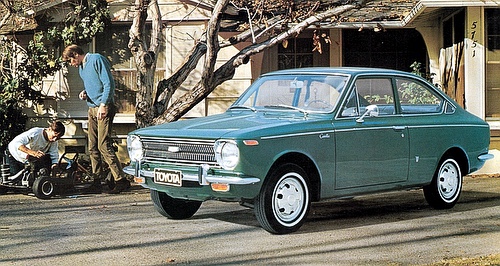News - General News - GoAutoGoAuto Oddspot: Aussie-made odditiesWe look back at some of the best-known – and weirdest – cars made in the land Down Under18 May 2022 By MATT BROGAN WHEN you ask most people about Australian-made cars, they are most likely to recall the Ford Falcon and Holden Commodore – and with good reason.
Ask anyone with a little industry knowledge and you may get a Toyota Camry or Mitsubishi Magna thrown into the mix, while those older than say, 35, will probably add a few other Holden and Ford models, maybe a Chrysler or two, and if you’re lucky, perhaps a once-popular Nissan.
But the further you dig, the more interesting and varied the models we once produced in this country become.
The Blue Oval gave us the Ford Falcon and Territory in recent years, but further back it also built the Fairlane (and LTD), Laser, Cortina, Capri and Escort, the Mazda-based Telstar and Nissan-based Corsair.
Ford also assembled several American and British cars in its 91-year run, including the Anglia, Consul, Pilot, Prefect, Zephyr and Zodiac – not to mention the Model T and Model A, and the very first sedan-based ute.
Holden – more correctly General Motors Holden – has an equally diverse oeuvre. Apart from the Commodore, the red team also gave us the mighty Monaro, the Kingswood, the Camira, the Torana, and luxury models such as the Brougham, the Statesman and the Caprice.
And, like Ford, Holden offered a wide variety of badge engineered models assembled here (and elsewhere) including those from Bedford, Chevrolet, Isuzu, Nissan, Opel, Suzuki, Toyota and Vauxhall.
Travel back even further in time – did you know Holden made horse saddles before branching out into cars? – and we find an all-embracing array of American and British marques including models from Austin, Buick, Chevrolet, Chrysler, Cleveland, DeSoto, Dodge, Essex, Fiat, General Motors, Hillman, Hudson, Humber, Hupmobile, Morris, Oakland, Oldsmobile, Overland, Pontiac, Reo, Studebaker, Willys-Knight and Willys-Overland.
But local production was much more than a two-horse race...
Founded in 1926, AMI (Australian Motor Industries) produced mostly CKD vehicles from AMC (including Rambler models) and Leyland, as well as Mercedes-Benz, Standard, Talbot, Triumph, Vanguard and Toyota; the Japanese firm gradually increased its shareholding in AMI, which was transformed into Toyota Motor Corporation Australia in the late Eighties.
BMC, and later British Leyland Motor Corporation Australia, Leyland Motor Corporation and eventually JRA Limited produced Austin, Leyland, Morris, Mini (including Moke), Wolseley – and even Peugeot models. Incidentally, an imported, badge-engineered version of the Honda Accord was sold locally as the Rover Quintet.
Toyota, meanwhile, assembled a long line of its own models between 1963 and 2017, such as the Aurion, Avalon, Camry (and Holden Apollo), Corona, Corolla (and Holden Nova) and Tiara.
Meanwhile, the Rootes Group produced a range of Hillman, Humber and Singer vehicles before merging with Chrysler Australia in 1965. Chrysler, who had already been successful with model lines from DeSoto, Dodge and Plymouth, subsequently fashioned its own “locally engineered” (or should we say “badge engineered”) vehicles, including the Chrysler Royal, DeSoto Firesweep, Dodge Custom Royal and Plymouth Belvedere.
Chrysler also built the oddball French-made Simca Aronde from CKD kits, the Yank Tank Dodge Phoenix, and eventually Centura, Charger, Pacer, Valiant and VIP models before being taken over by Japan’s Mitsubishi Motors in 1981.
After a brief time selling the Mitsubishi Sigma as a Chrysler model, Mitsubishi Motors Australia Ltd purchased the remaining shares of Chrysler Australia and began building its own models here. First the Sigma, then the Colt, Magna, Verada and 380, before winding up local production in 2008.
Mitsubishi and Toyota weren’t the only Japanese car firms to produce vehicles Down Under. Nissan also assembled several models locally – initially as the Pressed Metal Corporation (PMC) with the Bluebird in the mid 1960s. Nissan and Datsun eventually produced the 1200 and 1600 locally, as well as Pintara, Pulsar and Skyline variants right up until 1992.
We also had a couple of fully-fledged European manufacturers operating in Australia, including Renault and Volkswagen. Renault, based in Heidelberg, produced the 10, 12, 16 and 18 and several Peugeot models (sacre bleu!), while Volkswagen gave us the Aussie-made Beetle, Country Buggy and Kombi, and later even a handful of Volvo models.
Of course, it wasn’t just the big-name brands that had their time under the Australian sun.
Australia made its own Australian Six here for over a decade before meeting its demise during the Great Depression. We also had Bolwell, Brabham, Bushranger, Elfin, Joss, Purvis, Goggomobile, Robnell, Southern Cross and even Studebaker (the latter for six whole years).
In all, some 80 minor brands had a crack at building cars Down Under, and that’s before we mention tuning companies such as CSV, HSV, Tickford and Walkinshaw. But that’s a story for another day…
Sadly, little remains of what once was. Australia is now reliant on other countries for new vehicles, and increasingly, for just about everything else as well… Be it farm machinery, trucks, trains, trams and buses, there’s little we actually make any more – which is a great pity when you stop to consider just how truly diverse our manufacturing base once was.  Read more23rd of April 2022  GoAuto Oddspot: Kids these days…Has the modern car made life too easy for Learner drivers? And isn’t that a good thing?18th of March 2022  GoAuto Oddspot: The bad and the uglyWhen it comes to truly terrible automotive design, we reckon these cars are the world’s worst |
Click to shareGeneral News articlesResearch General News Motor industry news |
















Facebook Twitter Instagram